In an effort to consolidate the vast amount of shoes I’ve been able to try in the last 4-6 months, I’m going to group shoes into a couple categories and give brief reviews on each of them. I’m still planning on doing in depth reviews on shoes as well (and have a few shoes already set aside to do so) but in an effort to give some testing feedback on as many shoes as possible I’m going to put together three different round-up reviews of Light Trail Shoes, Protective Trail Shoes and Mountain Running Shoes. Hopefully there is at least a shoe or two that every reader is/was curious about! The second in this series is going to be the Protective Trails Shoes and there are some great new shoes in this category this year. I’ve ranked them in roughly the order of my most favorite first to the shoe needing the most improvement at the end. Specs via Running Warehouse (click on shoe name) unless otherwise indicated.

1. Montrail Trans Alps – 365 g (13.0 oz) mens 9, 29mm H, 21mm FF, $130.00
Montrail has successfully, in my view, rebooted and reinvigorated their trail line-up in 2016. Despite some restructuring as a company, and further re-branding coming in 2017 where they will be called Columbia Montrail, they still managed to put together some good product (see previously the reviewed Caldorado) . I almost wrote off the Trans Alps when I first saw it. Fortunately, Montrail sent me a pair anyway and I was more than surprised at how well the shoe ran. What looks like a lead filled hiking shoe with tank-like construction runs really smoothly and is the most protective shoe I’ve probably ever run in while still be enjoyable to run in. The outsole is aggressive, yet not overly so and it has a supportive and yet still comfortable upper.
The midsole geometry and design is what really saves this shoe. It features Montrail’s Fluid Guide construction which has a graduated, seamless density of foam that is softer in the heel and gradually firmer through the midfoot and then softer in the forefoot. The result is a very stable shoe that transitions really well for how stiff and protective it is. The shoe has a rock plate and external midfoot shank too which further adds to its ridiculous levels of protection and support. I, for one, am glad Montrail is willing to produce a shoe like this, which is nice to have in the tool bag for long and rough ultramarathon events and mountain adventures. I equally enjoy their F.K.T. treatment to the Trans Alps that came out this fall where they simplify the upper and remove the Fluid Guide to lighten of up the shoe and allow for a more nimble option on the same platform. Very good shoe from Montrail, one of my favorite new shoes this year, and one of the best values on the market since the shoe is easily a 1000 mile shoe I would guess based on the near zero wear I’ve had over a hand full of rough mountain style outings in it already.
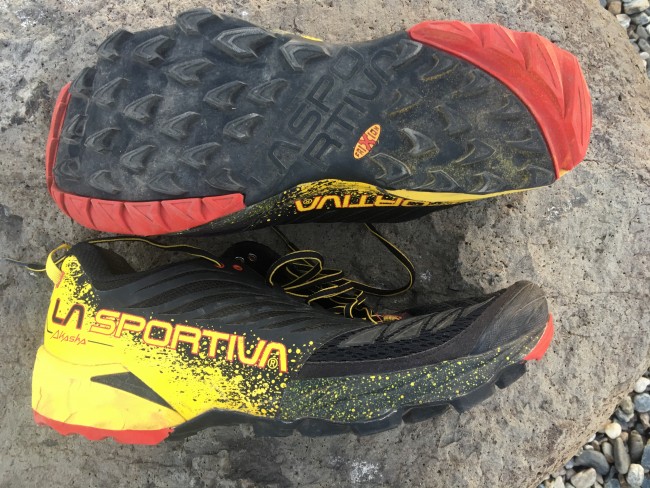 2. La Sportiva Akasha – 285 g (10.1 oz) mens 9, 31mm H, 25mm FF, $140.00
2. La Sportiva Akasha – 285 g (10.1 oz) mens 9, 31mm H, 25mm FF, $140.00
La Sportiva doesn’t come out with as many new models as other brands, but when they do, I usually pay attention since they build shoes with a very purpose-built mountain design aesthetic. The Akasha is their most highly cushioned shoe to date and the focus of design was on building an all-around trail and mountain shoe that could handle a variety of terrain and distances. I think they’ve generally met that goal and the Akasha is one of the better all around, protective models I’ve tried this year with good precision for the level of protection and a comfortable yet secure upper. One of La Sportiva’s strengths has always been its fantastic rubber compounds for their outsoles and the Akasha is another representation of this. It uses a combination of the sticky XF rubber in addition to small amounts of the more durable AT compound (red rubber) at the heel and big toe. The rubber wears really well and performs even better with great traction on most every surface. The lug shape (one aspect of design I have keen interest in) is good too with lugs going in the direction of travel when they should an providing breaking traction in appropriate areas.
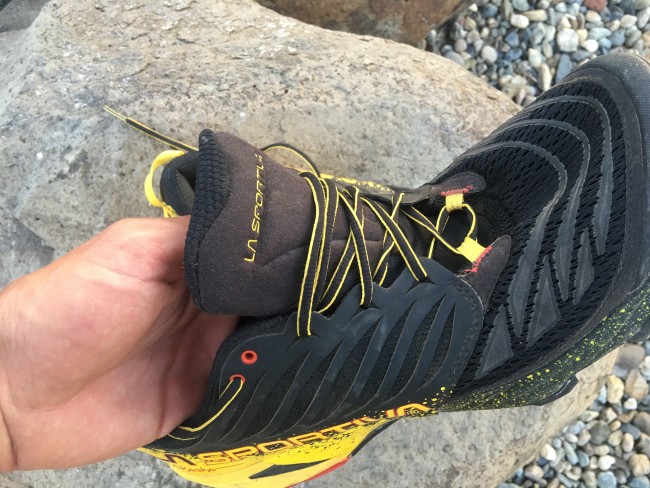
Great tongue padding that distributes lace pressure. Overall a pretty good upper on the Akasha.
The midsole is a decent (though not outstanding) injection molded EVA that offers enough life and cushion, yet is still firm enough to not be too squishy or unstable on more technical terrain. I did modify the heel after a few runs to narrow up what, in my view, was too chunky of a design that was the only glaring flaw in the ride. After doing so, the shoe performs very predictable on downhills and uneven terrain and in accordance with its protection and stack height. For runners that are looking for one shoe to cover a wide variety of applications, the Akasha would be near the top of the list as a fantastic all-arounder.

Narrowed the somewhat fat heel down a bit and it made a ton of difference on technical descents…much better heel compliance and stability, plus it saves nearly half an ounce (15 grams).
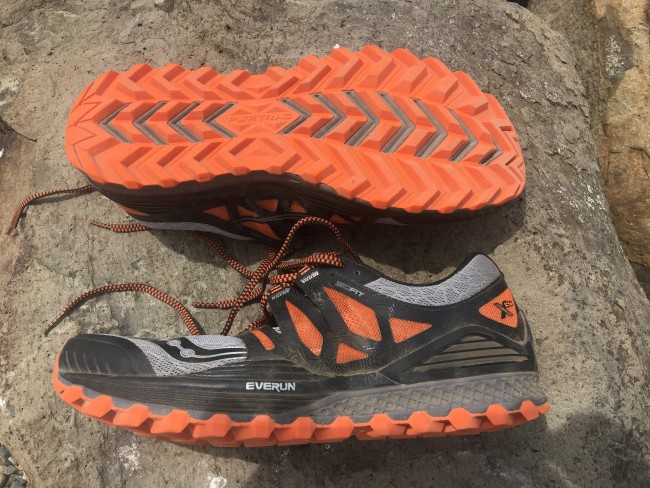 3. Saucony Xodus ISO – 297 g (10.5 oz) mens 9, 29mm H, 25mm FF, $130.00
3. Saucony Xodus ISO – 297 g (10.5 oz) mens 9, 29mm H, 25mm FF, $130.00
I haven’t had great luck with Saucony’s trail line in the past. The Peregrine 5 is probably the best of the bunch and I did like some things about the Nomad TR. I’ve not tried previous versions of the Xodus, mainly because they looked overbuilt, heavy and too tapered in the toebox. Saucony made a significant overhaul to the Xodus with the new Xodus ISO. The fit in the heel and midfoot is very good, particularly for a Saucony. It is secure, but the ISO overlays don’t cut into the foot at all. The only glaring issue with the fit for me is the still, very noticeable tapered toebox. I’d recommend sizing up a 1/2 size in them to alleviate this issue. As is, with my size being 13, I can’t size up a 1/2 size to remedy this so the shoe ends up feeling a bit short at the big toe due to the taper. The midsole and ride of the shoe are above average. The geometry is good and they keep the profile narrow enough to not feel bulky. The Everun topsole does help give a little life to the otherwise somewhat dead and firm-ish compressed eva. The shining component is no doubt the PWRTRAC outsole. It is making its way onto most all of Saucony’s trail shoes at this point and is a great soft, but durable compound and in a good tri-flex patter on the Xodos ISO. I really like this outsole and if it was on something closer to the Nomad TR last, it would be a big win for long mountain races/runs.
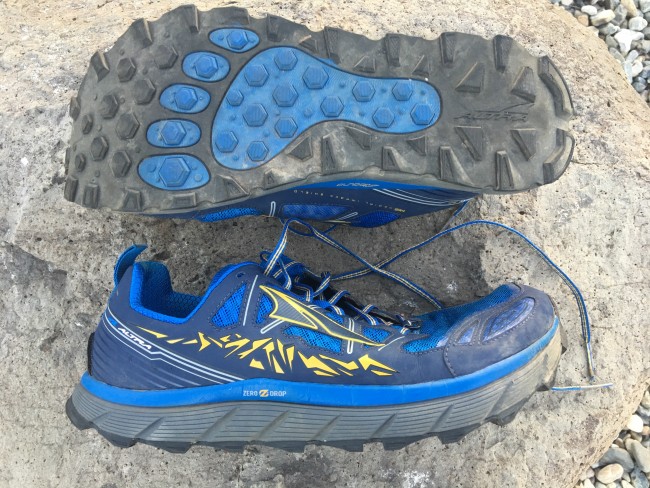 4. Altra Lone Peak 3.0 – 277 g (9.8 oz) mens 9, $120.00, available July 2016
4. Altra Lone Peak 3.0 – 277 g (9.8 oz) mens 9, $120.00, available July 2016
I tend to think of Altra’s Lone Peak as their most recognizable model and it has surely seen great success in the last few years and they are solid fixture at every trail race I go to. The 3rd full version sees the most substantial update of all versions before it with entirely new outsole, midsole and upper. I had some issues, particularly with the upper not being secure enough on the Lone Peak 2.5, but really liked the Neoshell version in which the neoshell upper is more secure by not stretching during the run. The Lone Peak 3.0 attempts to address some of the issues I had with the 2.5. First, the midsole is a little softer and gives a slightly more responsive ride to it which makes it run better on hardpack/smoother trail; more responsive and lively which I like. That said it feels like there is a little more stack height and a slightly softer foam so it comes across as an almost quasi-maximalist experience in feel to me and drifts just bit away from the core Lone Peak position as Altra’s all around trail option. I tested this out on two different Lone Peak 3.0s (pre-production model and production pair) and it still feels softer and more flexible than the 2.5. This basically creates a bigger gap between the Superior and Lone Peak experience. Oddly enough, with the added stack, there actually seems to be less structure to the midsole due to the midsole compound being slightly softer and softer outsole rubber as well compared to the 2.5. This results in a more flexible ride overall and bit more bouncy feel (good on hardpack, but worse on uneven/tech ground for my tastes) and it leaves me feeling that the shoe just doesn’t quite commit to either being a more protective, bomber long run option (which is what I always have wanted it to be) or more minimal/lighter option since it has elements of both. Since I’d prefer the more protective approach (lighter option is already the Superior) I think they could thicken the Stoneguard rock plate (which feels pretty light) to add some structure to the soft and flexible ride which would also give the shoe just a bit more spine and protection for the long outings is it best suited for.
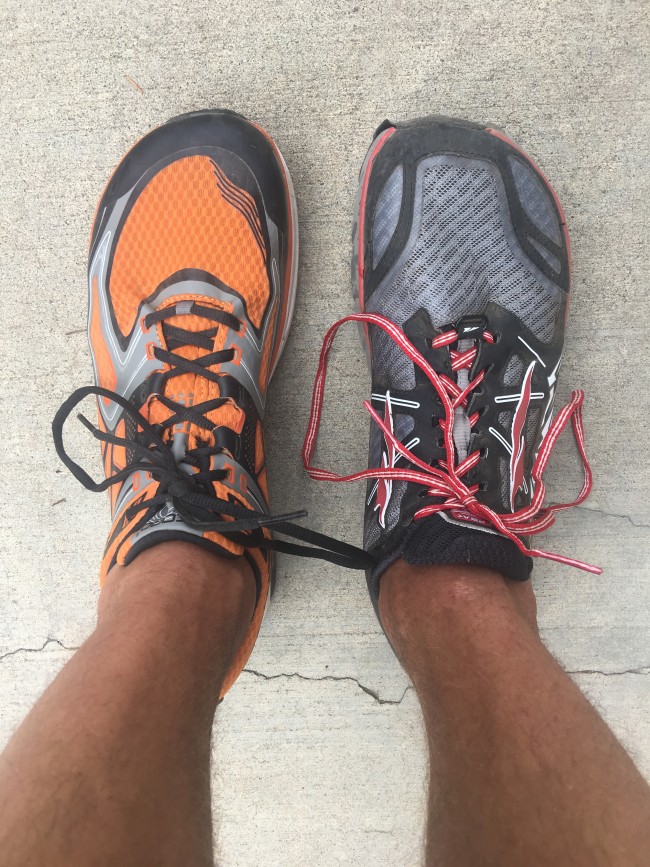
Too much volume in the midfoot on the Lone Peak 3.0 last. Shown in comparison is the Topo Athletic Ultrafly which has a very similar toebox but much more secure midfoot…you don’t have to have a loose midfoot to have a wide toebox.
The upper is much improved with solid overlays and a much better heel fit than almost any other Altra I’ve tried. Good progress in the upper. However, the last is still too voluminous in the midfoot for my tastes and I have trouble getting the shoe tight enough on technical descents, however, it is a lot better than the 2.5. I just ran in the new Altra Torin 2.5 for the first time and the performance last on it is great; super wide in the forefoot yet still secure in the midfoot and heel. I’d love to see the Lone Peak on this performance last, but I’m just not sure if much of Altra’s runner base prefers extra volume in the midfoot/instep and I’m in the minority or if there are more runners out there that would prefer a more secure fit. I still think the shoe is an improvement over the 2.5, but it still being held back from being great in the small ways I’ve mentioned. I’ve always imagined the Lone Peak to have the potential to be the perfect long distance trail shoe, but it still falls just a bit short for me. All in all a good shoe and I’m really looking forward to the mid-height winter version coming in a few months. It think it has tons of potential for being a great winter running shoe as well as a light hiking shoe for backpackers/through hikers.
 5. Pearl Izumi Trail N3 – 300 g (10.7 oz) mens 9, 29mm H, 21mm FF, $135.00
5. Pearl Izumi Trail N3 – 300 g (10.7 oz) mens 9, 29mm H, 21mm FF, $135.00
Pearl Izumi and their E:Motion line has been a staple in the trail and ultra running scene for the last 3-4 years. Their comfortable uppers and well rounded models have been well received and the shoes generally work as intended. They offer good middle of the road cushion, protection and traction with soft and comfortable seamless uppers. All of these good qualities make them great options particularly for the runner who wants one shoe to do everything. However, as I’ve discussed in my previous review of the Trail N2v2 and N1v2 the lines get blurred a bit between the models where the N1 and N2 aren’t that differentiated featuring similar protection and cushion at similar weights. Unfortunately the Trail N3 continues this trend with it coming in at nearly the same weight as the N2v2 (and N2v3) and while softer with more cushion, the protection feels somewhat similar as well. The good news is that all the features that you’ve come to expect from PI are there with a soft and comfortable upper, smooth-ish rockered ride, rock plate and good protection to weight ratio. That said, being that it still comes in as a very similar middle of the road option with just slightly more cushion than the N2, I’m just not sure where they differentiate the line that much and it will lend to runners buying just one of the models rather than considering two or all three as different tools for different uses. As it is, I see them as very similar tools with just slightly different leanings. The N3 runs pretty decent, fits well and works as advertised but doesn’t bring anything new to the table, nor blow me away on any level. In the end, I think I still probably would go with the N2 to split the difference between the N1 and N3 and have it give me the best of both models. Since reviewing these, Pearl Izumi announced they are shutting down their run division. Definitely an interesting move by PI and in many ways sad to see them go.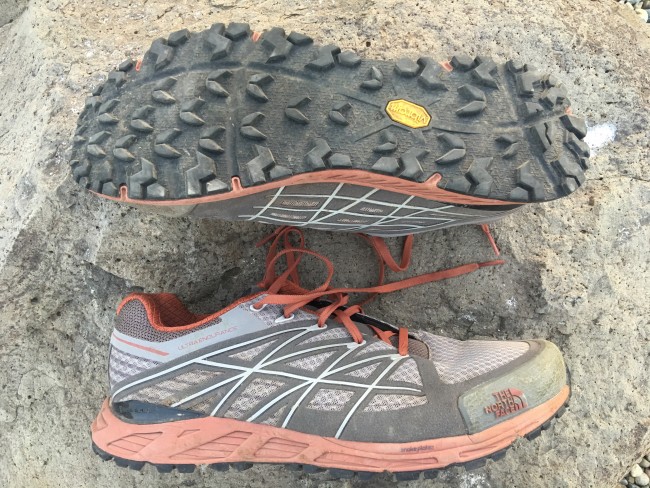
6. The North Face Ultra Endurance – 323 g (11.4 oz) mens 9, 26mm H/18mm FF, $125.00
I was pleasantly surprised by the North Face Ultra MT last year which had a great mountain design and was the first shoe I ran in with the, then new, Vibram Megagrip rubber compound, which is fantastic. Seeing that the Ultra Endurance was going to feature a more shallow lugged outsole with Megagrip on a more well-rounded platform, I was pretty excited to test out the results. It was supposed to have injected EVA, rock plate (North Face calls it a Snake Plate) and middle of the road 8mm drop. Turns out, they couldn’t have gone with the injected EVA (that or it is really poor foam) and it instead features just a generic low grade EVA material that substantially detracts from the shoe. This shoe runs very dead to me and it is such a shame! In this day and age, you just can’t get away with that low of quality of foam and hope runners don’t notice. Secondly, the rock plate literally feels like they forgot it. The shoe feels thinner and less protective than many other shoes I’ve tried this year but at an 11.4 ounce weight this just makes no sense. They need to beef the rock plate up quite a bit to give the shoe some structure and protection. The upper is actually somewhat decent fitting, although, arguably lower volume for most folks for the type of end use it is marketed for (long trail runs). The outsole is the one shining point with a great design and of course great rubber compound. The shoe need not be just discarded and is completely salvageable in a version 2 if they can upgrade the foam and beef up the rock plate…maybe lighten the upper up a bit here and there and have a little taller toebox height it really could be a sweet little shoe. As is, I can’t really recommend it other than for casual hiking or something.



















“I just ran in the new Altra Torin 2.5 for the first time and the performance last on it is great; super wide in the forefoot yet still secure in the midfoot and heel.”
Very nice to hear (or read) that. How does the Torin 2.5 fit compare against Topo shoes?
I see Altra is now classifying their shoes with a last label (ex: Torin 2.5 is labeled PFS2). So shall I make a small request? A post describing each Altra last in the point of view of Runblogger :)
~
“I’m just not sure if much of Altra’s runner base prefers extra volume in the midfoot/instep and I’m in the minority or if there are more runners out there that would prefer a more secure fit.”
I think we can say both are true; Altra would madden (and lose) much of their loyal base and at the same time would gather a new (and bigger base) if they change their midfoot/heel fit to be more secure and narrow. (Just my guess)
Great feedback on this and while I might not do a post on lasts for Altra here is the basic rundown of known lasts starting from most secure to least…as you can guess the most secure are the ones that fit best for me.
RFS (racing): Golden Spike XC flat and forthcoming King MT trail shoe
PFS: (performance): Torin, Superior and forthcoming Escalante and Timp iQ, I believe One 2.5 is as well but don’t have material to confirm this in front of me.
SL: (standard variant): Provision 3.0…not sure what L stands for, but it fits better than SD for me.
SD: (standard): Lone Peak, Instinct, Paradigm, Olympus…some have different numbers but generally they fit similarly for me with olympus and paradigm being a bit more secure than LP and Instinct…Instinct 4 is better but it goes back to older Instinct 1.5 last.
That help? -David
It helps a lot. Thanks!
Looking forward for King MT and Escalante. And Topo Terraventure! And Torin 2.5, of course. Lot of options (narrow heel wide forefoot) now!
Oh and regarding Torin fit. It is similar to Topos in midftoot and heel (maybe just a hair less secure) but much more wide in the toebox. It’s probably one of the widest toeboxes I’ve ever stuck my foot in!
-David
Seems like a very good shoe to pound the pavement with easy/long runs!
hi david–welcome back! i’m trying to choose between caldorado, trans alps, and trans alps fkt. would caldorado still be a better choice for not too technical terrain? i’m hoping to get something that could also work well doubling as a hiking shoe. any disdavantages of fkt vs. original trans alps? might it run as smoothly as caldorado?
have you tried rogue fkt?
and on the lighter side, is there much dif. in the ride of fluidflex fkt vs. st?
thanks,
bruce
Hi Bruce,
I think the Trans Alps would be my pick if I was going to double as a hiking shoe. The FKT is lighter in both upper and midsole (and softer). I like both of them for different reasons and you can’t go too wrong with either (and they are cheap right now due the the rebranding they are undergoing!). I think the Trans Alps runs smoother than the Caldorado and the Trans Alps FKT probably is a good compromise between the Trans Alps and Caldorado (weighs the same or maybe a bit less than Caldorado even).
I’ve tried the Rogue FKT on but not run in it. I was thinking at the cheap price on RW, I might give it a whirl. It isn’t going to be super protective but light and nimble.
As far as the FKT vs ST the ride isn’t really different just the upper. I prefer the FKT upper (lower volume and lower heel collar height) but the ride is equally decent on both.
Take care. -David
thanks, david. do you find any difference in fit, snugness, or sizing among the two trans alps and the caldorado?
Trans Alps is a bit more snug than Caldorado but not drastically so and all are what I’d consider medium fitting shoes. Trans Alps FKT fits same as regular TA but maybe a bit more stretch to fabric since it lacks the rand of the regular Trans Alps. Biggest difference between those two is that the reg TA has lace loops and TA FKT doesn’t so it laces at an effective lower volume (even though last volume is the same).
sorry, david, just to be sure i’m clear, you’re saying fkt laces at a lower volume, right?
i briefly tried on caldorado at a store and was able to size down comfortably. do you think that would be the case also with the two trans alps?
thanks again,
bruce
Yes the FKT laces at a lower. I’d say the Caldorado seemed a bit larger than the TA and it is a different last too. Personally I wouldn’t size down but can’t say for sure.
David
So, after reading this article and the posts, it seems that the best “fit” for “narrow heel and midfoot, and wide toebox” could be a TOPO (Runventure or MT), isn’t it?
Anyother option?
Some months ago I made exactly this question and here are some other options:
link to runblogger.com
(Nike Kieger 3, New Balance NL-1 last, inov-8 Standard Fit, Skecher newer models)
TOPO is good in this regard, but I do actually prefer Nike’s trail shoe fit (Kiger 3 and Wildhorse 3) probably better than TOPO even. Skechers is getting better too in this regard although I wouldn’t say their heel is narrow but medium. Altra will also have a new shoe called the King MT that will be on their Racing last and it should fit narrow from heel through midfoot but with wider forefoot. I’ll be covering many of these as they get released. -David
Thanks!
Never thought on the Nike Kieger 3! If you say it is narrow on heel and midfoot, but wide on toebox it could be perfect for me. Thanks again!